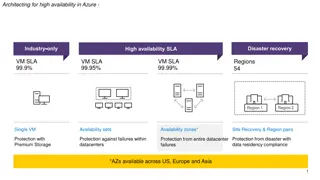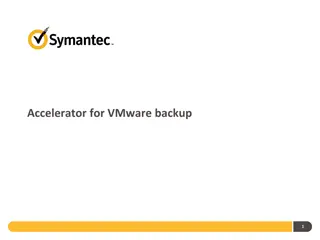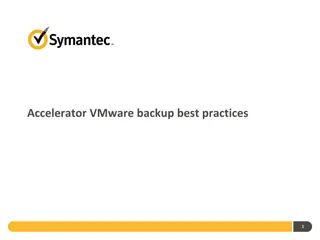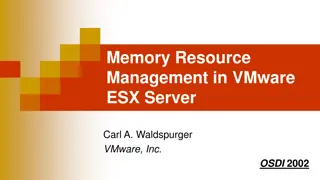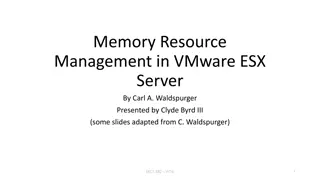Understanding VMware High Availability Deep Dive Concepts
Dive into the world of VMware High Availability with in-depth modules covering admission control policies, slot sizing, advanced settings, and failover capacity. Learn about cluster tolerance, slot reservations, resource fragmentation, and worst-case scenarios to optimize your virtual environment for maximum availability and performance.
Download Presentation

Please find below an Image/Link to download the presentation.
The content on the website is provided AS IS for your information and personal use only. It may not be sold, licensed, or shared on other websites without obtaining consent from the author. Download presentation by click this link. If you encounter any issues during the download, it is possible that the publisher has removed the file from their server.
E N D
Presentation Transcript
VMWARE HA DEEP DIVE Eric Sloof NTPRO.NL
MODULE 1 Admission Control Policies
MOST CONFIGURED ADMISSION CONTROL POLICY
HOST FAILURES A CLUSTER TOLERATES ESX01 ESX02 ESX03 Shared storage vm.vmdk
DEFAULT MINIMUM SLOT SIZE VM3 VM4 VM..n VM1 VM2 32 MHz 69 MB If you have not specified a CPU reservation for a virtual machine, it is assigned a default value of 32MHz. When the memory reservation is 0, the slot size equals the virtual machine overhead.
SLOT SIZE BASED ON RESERVATION VM1 VM2 VM3 VM4 VM n 512 MHz 1093 MB vSphere HA calculates the CPU and memory slot size by obtaining the largest CPU and memory reservation of each powered-on virtual machine.
HA ADVANCED SETTINGS das.slotmeminmb das.vmmemoryminmb Memory reservation SLOT das.slotcpuinmhz das.vmcpuminmhz CPU reservation SLOT
VMS REQUIRING MULTIPLE SLOTS VM1 VM3 VM2 VM4 VM5 VM6 512 MHz 512 MB Slot size Reservation You can also determine the risk of resource fragmentation in your cluster by viewing the number of virtual machines that require multiple slots. VMs might require multiple slots if you have specified a fixed slot size or a maximum slot size using advanced options.
FRAGMENTED FAILOVER CAPACITY ESX1 ESX2 ESX3 Shared storage vm.vmdk
WORST CASE SCENARIO ESX01 3.6 GHz 16 GB ESX02 3.6 GHz 16 GB ESX03 3.6 GHz 32 GB Shared storage vm.vmdk
KEEP HOSTS THE SAME SIZE Host memory: 2 * 16 GB 1 * 32 GB Host memory: 3 * 16 GB
PERCENTAGE OF CLUSTER RESOURCES RESERVED ESX01 ESX02 ESX03 Shared storage vm.vmdk
PERCENTAGE RESERVED AS FAILOVER CAPACITY
ADMISSION CONTROL BASED ON RESERVATIONS vSphere HA uses the actual individual reservations of the virtual machines. The CPU component by summing the CPU reservations of the powered-on VMs.
COMPUTING THE CURRENT FAILOVER CAPACITY If you have not specified a CPU reservation for a VM, it is assigned a default value of 32MHz
RESOURCES RESERVED IS NOT UTILIZATION The Current CPU Failover Capacity is computed by subtracting the total CPU resource requirements from the total host CPU resources and dividing the result by the total host CPU resources.
PERCENTAGE RESERVED ADVANCED SETTING The default CPU reservation for a VM can be changed using the das.vmcpuminmhz advanced attribute das.vmmemoryminmb defines the default memory resource value assigned to a VM
SPECIFY FAILOVER HOSTS ADMISSION CONTROL POLICY ESX01 ESX02 ESX03 Shared storage vm.vmdk
SPECIFY FAILOVER HOSTS ADMISSION CONTROL POLICY Configure vSphere HA to designate specific hosts as the failover hosts
THE FAILOVER HOST To ensure that spare capacity is available on a failover host, you are prevented from powering on virtual machines or using vMotion to migrate VMs to a failover host. Also, DRS does not use a failover host for load balancing If you use the Specify Failover Hosts admission control policy and designate multiple failover hosts, DRS does not attempt to enforce VM-VM affinity rules for virtual machines that are running on failover hosts.
STATUS OF THE CURRENT FAILOVER HOSTS Green - The host is connected, not in maintenance mode, and has no vSphere HA errors. No powered-on VMs reside on the host. Yellow - The host is connected, not in maintenance mode, and has no vSphere HA errors. However, powered-on VMs reside on the host. Red - The host is disconnected, in maintenance mode, or has vSphere HA errors.
CONCLUSIONS VMware High Availability needs to be configured Be careful with reservations Always check run-time information
MODULE 2 HA datastore heartbeats and host isolation
DATASTORE HEARTBEATS HOST-X-HB host-X-hb (where X is the host s MOID) Located on each heartbeat datastore, this file is used to check for slave liveness through the heartbeat datastore. This file is checked by the master host if the master loses network heartbeats from the slave. For VMFS datastores, the vSphere HA agent locks this file with an exclusive lock and relies on the VMkernel heartbeat to indicate liveness. For NFS datastores, vSphere HA periodically updates the time stamp to this file to indicate liveness.
DATASTORE HEARTBEATS HOST-X- POWERON host-X-poweron (where X is the host s MOID) A per-host file that contains the list of all virtual machines that are powered on. This file is used as a communication channel if a management network outage occurs. Isolated slaves use this file to tell the master that it is isolated as well as to tell the master which virtual machines it has powered off.
THE SLAVE DOES NOT RESPOND The master host must determine whether the slave host: Actually crashed Is not responding because of a network failure The HA agent is in an unreachable state The absence of both a network and datastore heartbeat indicates full host failure.
THE LABORATORY Gateway Slave Master Master ESX1-15Ghz-15GB ESX3-15Ghz-15GB host-X-hb host-X-poweron
CONCLUSIONS Datastores are used as a backup communication channel to detect virtual machine and host heartbeats. Datastore heartbeats are used to make the distinction between a failed, an isolated or a partitioned host.
VMWORLDTV http://www.youtube.com/VMworldTV










